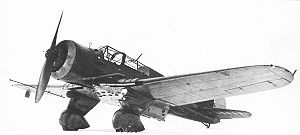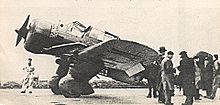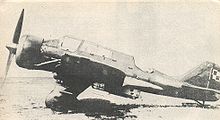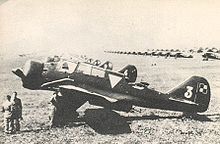PZL.23 Karas Video - Pictures
|
|
PZL.23 Karas
PZL.23 Karas

Picture - The third prototype PZL.23/III
Role: Light bomber and reconnaissance aircraft
Manufacturer: PaĊstwowe ZakĊady Lotnicze
First flight: 1 April 1934
Introduced: 1936
Retired: 1946
Primary users: Polish Air Force
Bulgarian Air Force
Produced: 1936 - 1938
Number built: 250 (+3 prototypes)
Variants: PZL.43 Karas
The PZL.23 Karas was a Polish light bomber and reconnaissance aircraft designed in the mid-1930s by PZL in Warsaw. It was the main Polish bomber and reconnaissance aircraft used during the Invasion of Poland.
Design and development

Picture - PZL.23A Karas (registered SP-BMF) on display during Paris Air Show in 1936
The aircraft was developed in 1931 to replace Breguet 19 and Potez 25 aircraft in the Polish Air Force. The main designer was StanisĊaw Prauss who based the design on a passenger transport project PZL.13 that was only a "paper" proposal. The design was of modern all-metal construction with wings built around light closed profiles instead of spars (introduced first in PZL.19). The P.23/I first prototype flew on 1 April 1934, followed by the second P.23/II prototype.
In the third P.23/III prototype of 1935, a pilot's seat was raised and the engine was lowered to obtain a better view. This prototype was accepted for a production, with the name Karas (in Polish - the crucian carp). The first series, PZL.23A was fitted with a Bristol Pegasus IIM2 radial engine of 670 hp (500 kW) produced in Poland under licence. Since this engine proved to be unreliable, the final variant PZL.23B was fitted with a newer Pegasus VIII of 720 hp (537 kW).
The aircraft was conventional in layout, low-wing cantilever monoplane, of all-metal, metal-covered construction. The crew consisted of three: pilot, bombardier and a rear gunner. The bombardier's combat station was situated in a gondola underneath the hull, where he could also operate an underbelly machine gun. The fixed undercarriage was well spatted, but despite a massive look, it was not suited for rough airfields. Bombs were carried under the wings: the maximum load was 700 kg (6 x 100 kg and 2 x 50 kg). The aircraft were equipped with one of the following engines: Bristol Pegasus IIM2 normal: 570 hp (425 kW), maximum: 670 hp (500 kW) - PZL.23A; Pegasus VIII normal: 650 hp (485 kW), maximum: 720 (537 kW) - PZL.23B. Regardless of the engine, the aircraft had a two-blade propeller.
The Bristol engines were licensed for use in Poland only, so for export purposes the Gnome-Rhx´ne 14K was used in a variety of PZL designs. In this case the 14K-powered PZL.23, with some changes to the airframe, became the PZL.43 Karas. Final export variant was PZL.23A, with 1,020 hp Gnome-Rhone 14N-01 engine. 52 PZL.43s were made in total, all for Bulgaria only. The new engine improved the aircraft's performance considerably, maximum speed increased to 365 km/h.
In 1936, 40 PZL.23As were produced. Between late 1936 and February 1938, 210 PZL.23Bs were produced with the new engines. They were also known as Karas A and B or Karas I and II. All PZL.23s had military numbers from 44.1 to 44.250.Sometimes the aircraft is called the "PZL P.23", but despite an abbreviation P.23 painted on a tail fin, the letter "P" was generally reserved for fighters of Pulawski's design (like PZL P.11). In November 1936, one aircraft was shown at the Paris Air Show, where it was met with interest.
During this period, PZL developed the PZL.46 Sum, a new light bomber, partly based on the PZL.23 design, but only two prototypes were completed in 1938. There was also a single experimental variant of the Karas, PZL.42, with double tail fins and a modified bombardier gondola, retractable into the fuselage.
Operational history

Picture - PZL.23A of the production series
Forty PZL.23As were delivered to the Polish Air Force in late 1936. Due to engine faults, their service ceiling was limited and they were used only in the training role, being fitted with dual controls. A total of 210 PZL.23Bs were delivered to the Air Force from 1937. They became the main armament of Polish bomber and reconnaissance "line squadrons", in the 1930s replacing Breguet 19, Potez 25 and Potez 27 biplanes. By August 1939, there were 23 crashes, what was an average safety result.

Picture - PZL.23A Karas on the Warsaw Airport. Note lines of PZL P.11 or PZL P.7 fighters in the background
By 1939, the aircraft was obsolescent. Its main deficiency was its low speed but a lack of manoeuvrability was also a problem (it was noted, that the maximum speed of the PZL.23B was 365 km/h, but it was forbidden to exceed 319 km/h due to dangerous flight characteristics). At the outbreak of World War II on 1 September 1939, during the invasion of Poland. Some aircraft were also used in wartime improvised units, 114 PZL.23Bs were deployed in combat units (a further 75 PZL.23B and 35 PZL.23A were in air schools, held in reserve or under repair). The PZL.23Bs were operational in five bomber squadrons (Eskadra Bombowa) of the Bomber Brigade and seven Army reconnaissance squadrons, each with 10 aircraft (other squadrons of the Bomber Brigade were equipped with PZL.37 ĊoĊ). In addition two PZL.43A from the Bulgarian order were impressed into the Polish service in the 41st Squadron.
On 2 September 1939, one PZL.23B of the 21st Squadron bombed a factory in Ohlau as the first bomb attack on the German territory. The PZL.23 bomber squadrons attacked German armoured columns, especially on 3 September 1939, while the main mission of Army squadrons was reconnaissance. The five squadrons of the Bomber Brigade delivered about 52-60 tons of bombs during the campaign, the Army squadrons added about a dozen tons of bombs as well.
Due to the type's low speed, lack of armour and especially fighter protection, PZL.23s suffered high losses. Many were shot down by the German fighter aircraft, but they also shot down a few in return. Despite lack of armour, crews often attacked German columns from low level, making their aircraft vulnerable to AA fire. Some 20 aircraft crashed on rough field airfields. About 120 PZL.23s (86%) were destroyed in 1939, but only 67 due to direct enemy action. Only a small number were destroyed on airfields with the only successful Luftwaffe attack on Polish combat units on an airfield during the campaign occurring on 14 September, at Hutniki, against PZL.23Bs of the Bomber Brigade.
At least 21 PZL.23s were withdrawn in 1939 to Romania with 19 used by the Romanian Air Force against the USSR. Fifty PZL.43s and PZL.43As (two were delivered by the Germans) were used in Bulgaria for training until 1946, known as the "Chaika". No PZL.23s were left in Poland after the war.
Operators
Poland
Polish Air Force
Romania
Romanian Air Force
Bulgaria
Bulgarian Air Force
Specifications (PZL.23A)
Data from
General characteristics
Crew: 3
Capacity: bomber
Length: 9.68 m (31 ft 9 in)
Wingspan: 13.95 m (45 ft 9 in)
Height: 3.3 m (10 ft 10 in)
Wing area: 26.8 m² (288 ft²)
Empty weight: 1,928 kg (4,251 lb)
Loaded weight: 2,813 kg (6,202 lb)
Max takeoff weight: 3,428 kg (7,557 lb)
Powerplant: 1x PZL Bristol Pegasus IIM2 9-cylinder radial engine, 670 hp (500 kW)
Performance
Maximum speed: 304 km/h (189 mph)
Cruise speed: 240 km/h (149 mph)
Stall speed: 110 km/h (68 mph)
Range: 1,260 km (783 mi)
Service ceiling: 7,300 m (23,950 ft)
Rate of climb: 6.5 m/s (1,280 ft/min)
Armament
Guns:
3 x machine guns:
1 x 7.92 mm PWU wz.33 fixed in nose;
1 x 7.92 mm Vickers F in rear upper station;
1 x 7.92 mm Vickers F in underbelly station;
Bombs: 700 kg (1,543 lb) bombs.
Specifications (PZL.23B)
General characteristics
Crew: 3
Capacity: bomber
Length: 9.68 m (31 ft 9 in)
Wingspan: 13.95 m (45 ft 9 in)
Height: 3.3 m (10 ft 10 in)
Wing area: 26.8 m² (288 ft²)
Empty weight: 1,980 kg (4,365 lb)
Loaded weight: 2,893 kg (6,378 lb)
Useful load: 913-1,546 kg ()
Max takeoff weight: 3,526 kg (7,774 lb)
Powerplant: 1x PZL Bristol Pegasus VIII 9-cylinder radial engine, 720 hp (537 kW)
Performance
Maximum speed: 319 km/h (198 mph)
Cruise speed: 270 km/h (167 mph)
Stall speed: 110 km/h (68 mph)
Range: 1,260 km (783 mi)
Service ceiling: 7,300 m (23,950 ft)
Rate of climb: 6.7 m/s (1,319 ft/min)
Armament
3 x machine guns:
1 x 7.92 mm PWU wz.33 fixed in nose;
1 x 7.92 mm Vickers F or PWU wz.37 in rear upper station;
1 x 7.92 mm Vickers F or PWU wz.37 in underbelly station;
700 kg (1,543 lb) bombs.
Related development
PZL.42
PZL.43 Karas
PZL.46 Sum
Comparable aircraft
Neman R-10
Heinkel He 70
Fairey Battle
A-35 Vengeance
Mitsubishi Ki-30
DAR-10
Bibliography
Angelucci, Enzo and Paolo Matricardi. World War II Airplanes (2 vol). Chicago: Rand McNally, 1978. ISBN 0-52888-170-1.
Axworthy, Mark, Cornel Scafes and Cristian Craciunoiu. Third Axis, Fourth Ally: Romanian Armed Forces in the European War 1941-45. London: Arms & Armor Press, 1995. ISBN 1-85409-267-7.
Cynk, Jerzy B. Polish Aircraft, 1893-1939. London: Putnam & Company Ltd., 1971. ISBN 0-370-00085-4.
Cynk, Jerzy B. Polskie lotnictwo myĊliwskie w boju wrzeĊniowym (in Polish). GdaĊsk, Poland: AJ-Press, 2000.
Cynk, Jerzy B. Polskie SiĊy Powietrzne w Wojnie Tom 1: 1939-43 (Polish Air Force in War pt. 1: 1939-43), Polskie SiĊy Powietrzne w Wojnie Tom 2: 1943-45 (Polish Air Force in War pt. 2: 1943-45) (in Polish). GdaĊsk, Poland: AJ-Press, 2002.
Cynk, Jerzy B. The Polish Air Force at War: The Official History. Atglen, PA: Schiffer Publishing, 1998. ISBN 0-76430-560-3.
Cynk, Jerzy B. The P.Z.L. P-23 Karas (Aircraft in Profile number 104). Leatherhead, Surrey, UK: Profile Publications, 1966.
Glass, Andrzej. Samolot rozpoznawczo - BombardujÄ
cy PZL - 23 Karas (TBIU Series) (in Polish). Warsaw: Wydawnictwo MON, 1973.
KopaĊski J. Tomasz. PZL - 23 Karas i wersja eksportowa (in Polish). Sandomierz, Poland: Stratus , 2004, ISBN 83-89450-16-X.
KopaĊski J. Tomasz. PZL - 23 Karas. Sandomierz, Poland/Redbourn, UK: Mushroom Model Publications, 2004. ISBN 83-89450-03-8.
Neulen, Hans Werner. In the Skies of Europe: Air Forces Allied to the Luftwaffe, 1939-45. London: Crowood Press, 2000. ISBN 1-86126-326-0.
PZL.23 Karas Pictures and PZL.23 Karas for Sale.
Living Warbirds: The best warbirds DVD series.
Source: WikiPedia